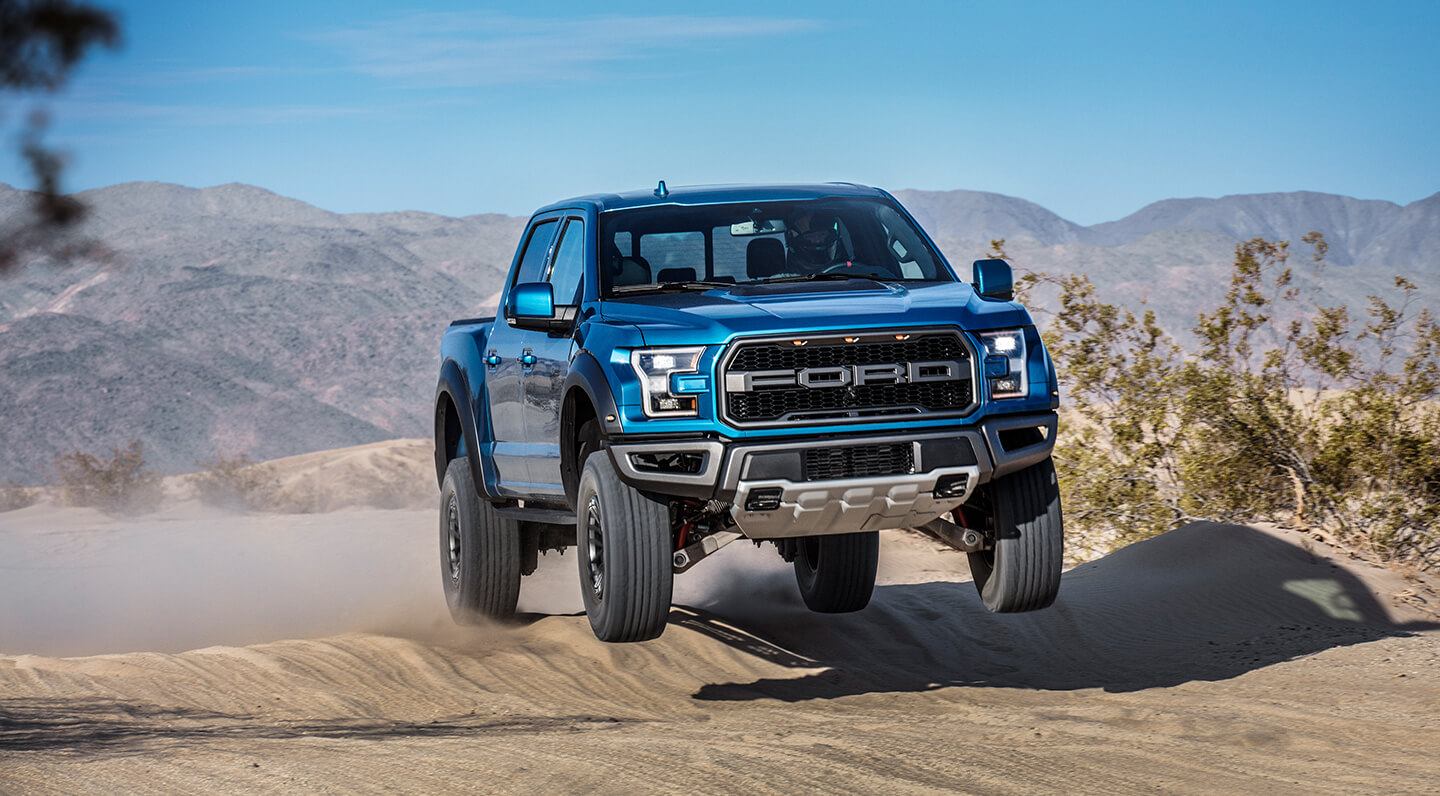
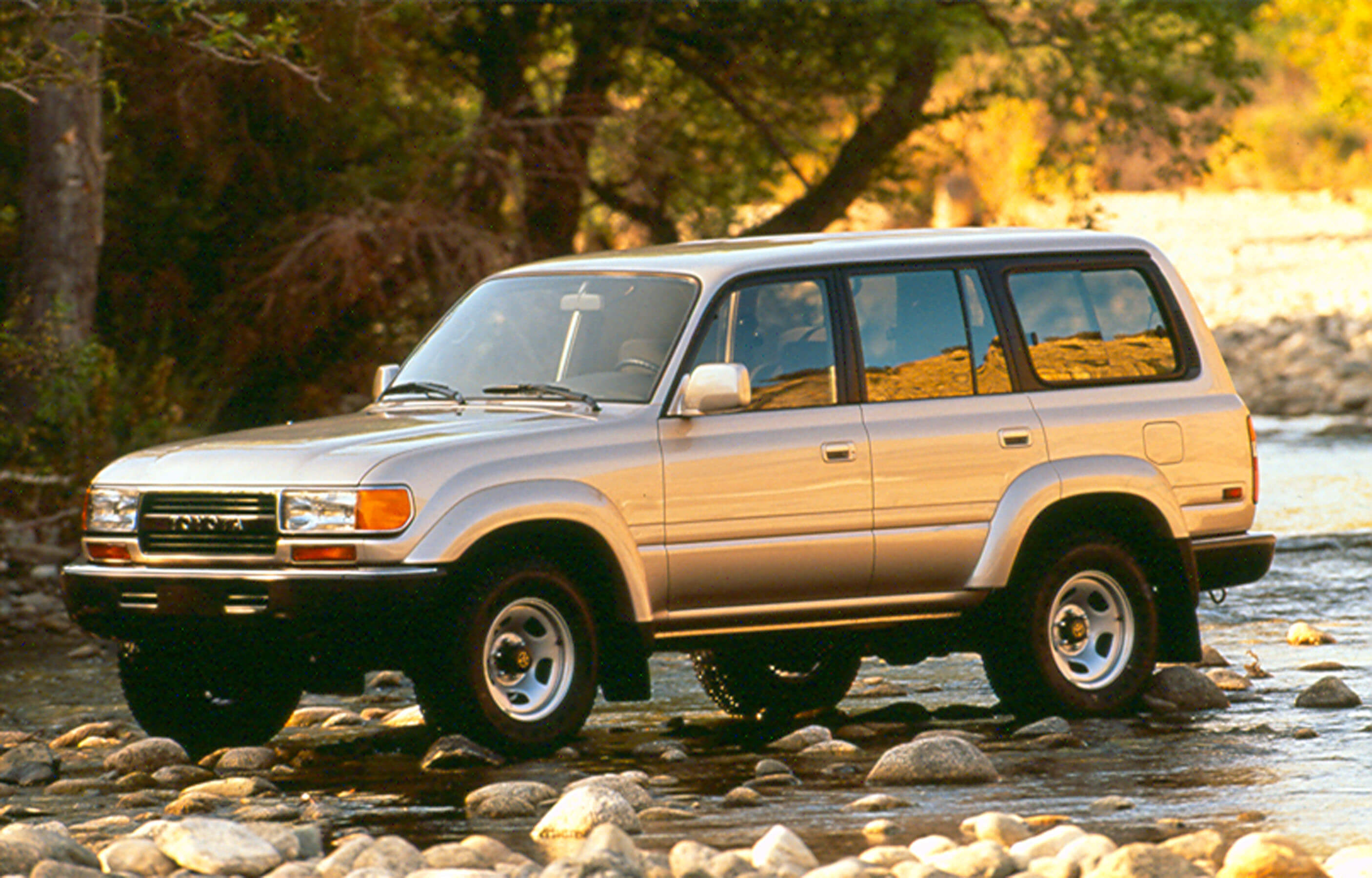
1990-97 Toyota Land Cruiser FJ80
The FJ-80 could be considered peak Toyota Land Cruiser. The rugged wagons were an ideal mix of off-road capability blended with on-road comfort and a heavy dose of Toyota dependability too. That reliability is a direct result of the bomb-proof straight six. The one to get is the 212 horsepower 4.5L I-6 with 275 lb-ft of torque on 1993-and-newer models. At the time, Toyota liked to say that 90 percent of that torque was available at 1,400 rpm, perfect for slow-speed four-wheeling. This six is undoubtedly no powerhouse, but it will run like forever. Although, it may need a new head gasket along the way. An FJ80 with 100,000 miles is considered practically new. At each end of the chassis is a beefy Toyota solid axle hung from the frame by links and smooth-riding coil springs. This suspension not only flexes well on the trail but offers an excellent ride. The most sought-after FJ80s for the trail are those ’93-up models that were optioned with Toyota’s factory front and rear lockers. Ditch the running boards, add some mud-terrain tires in place of the street-oriented 275/70R16 tires and a stock 80-Series can go some fairly amazing places. Don’t shy away from the Lexus version either. The LX 450 is a mechanical twin to the Toyota.
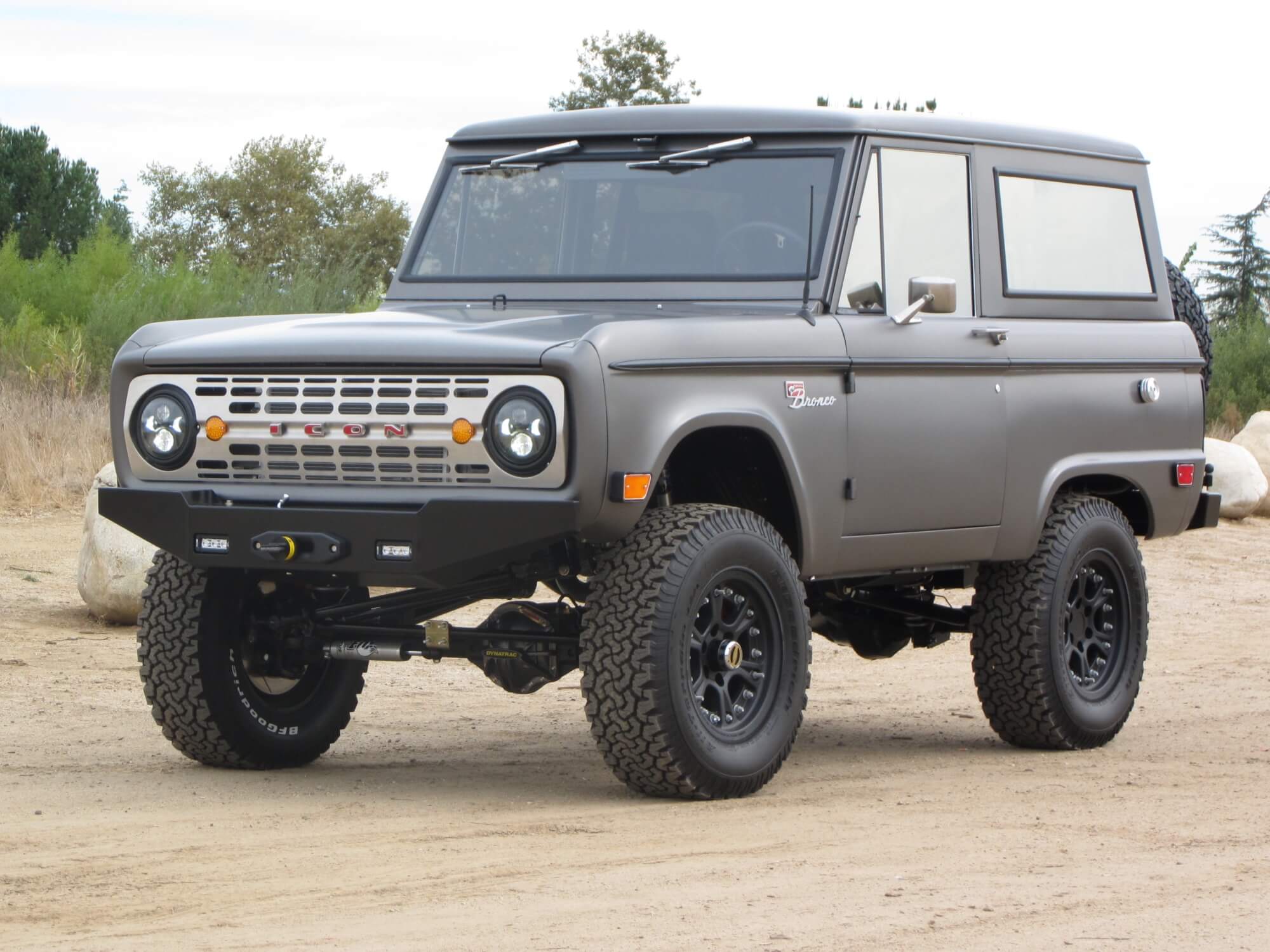
1966-77 Ford Bronco
Ford had the distinct advantage of studying Jeep for decades before it launched its own sport-utility in 1966. The Bronco used a longer wheelbase than the Jeep CJ and replaced the front leaf springs with coils. Those two factors alone meant the Bronco was a smoother rider and a better rig to zip across the desert at high speed. And the Bronco’s size meant it was roomy enough on the inside without being too large for tight trails. At each end, Ford used a beefy solid axle so that slow speed trail performance was excellent. Later versions (1971-up) used a big Dana 44 as well as Ford’s hefty 9-inch rear axle. And Broncos were offered the option of a limited-slip differential in both axles for excellent grip in the rough. Under the hood, there was a choice of either six-cylinder or V8-power. And in 1969 that meant Ford’s sweet 302 V8 was available. The most desirable model in terms of collectability and capability has to be the Stroppe Bronco from 1971-75. These machines were the Raptors of their day and could be had with a long list of hardcore off-road gear. These were the rigs that pioneered the “cut” fender look to fit wider and more aggressive tires. The Stroppe machines had a heavy-duty suspension too and options included full roll cages, push bars, and even Detroit Lockers. In mint condition, the early Bronco is a serious collectible. And they are very expensive. But enterprising ‘wheelers can find rougher, less pricey ones to enjoy on the trail too.
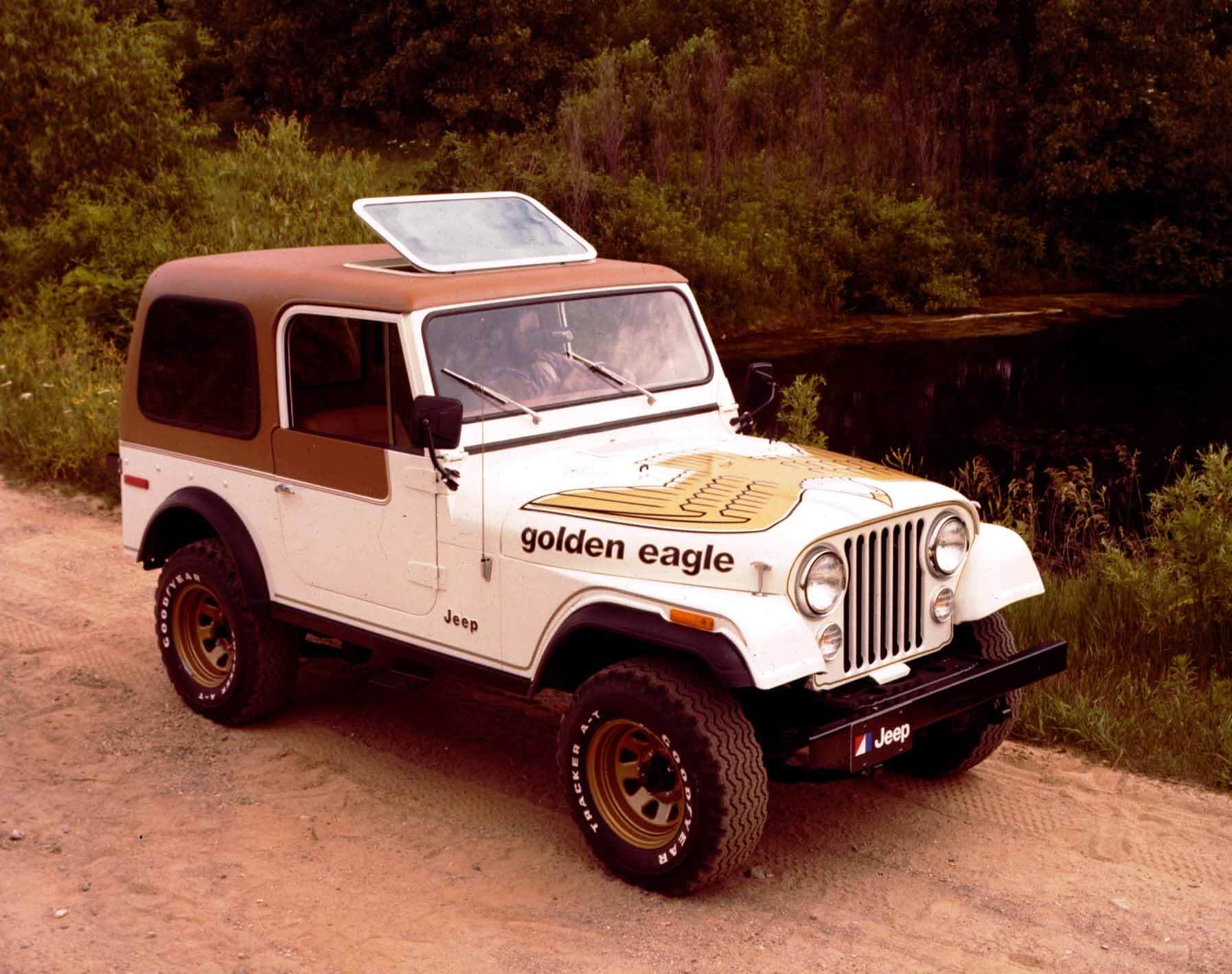
The original civilian Jeep CJ-2A started it all. Jeeps have gotten bigger and more comfortable over the years, but have still retained the capability of the original. One of our favorites is the CJ-7 Golden Eagle. Photo: Jeep
1945-86 Willys/Jeep CJ
The original civilian Jeep, the CJ-2A, was the archetype for just about every recreational 4WD vehicle that came after it. The very first Jeeps were small, lightweight and very durable. They were (and still are) easy to work on if they break down on the trail. And that’s a huge advantage compared to many new 4X4s. Better yet, with no top and no doors and a fold-down windshield, four wheelers cannot only see the trail but experience the adventure like no other 4X4. The original CJs were equipped with PTOs too, so they were used for real off-highway work like farming. The best of the bunch when it comes to flat fenders are the later CJ-3As, which had beefier drivetrains all around. The more recent curved fender CJ-5s, CJ-6s, CJ-7s and CJ-8s of the 1960s-1980s all make this list too because they are mostly the evolution of the original. Yes, they gained size, weight, and amenities. But the last CJs were also much better to drive to the trail. Our favorites of this breed? It has to be the 304 V8-powered models of the 1970s. And if we have to pick a wheelbase, the CJ-6 with its longer and more stable 101-inches between the axles (103.5 inches after 1972) is perhaps the one we’d build for trails. These early 1970s models received a stronger frame and could be had with strong T-18 four-speeds. And in terms of hardware, the final CJ-7s of the 1980s were sold with wide track axles (Dana 30 front and Dana 44 rear) as well as a Dana 300 transfer case. But we have a definite soft spot for the wacky late 1970s Golden Eagle CJ-7s too.
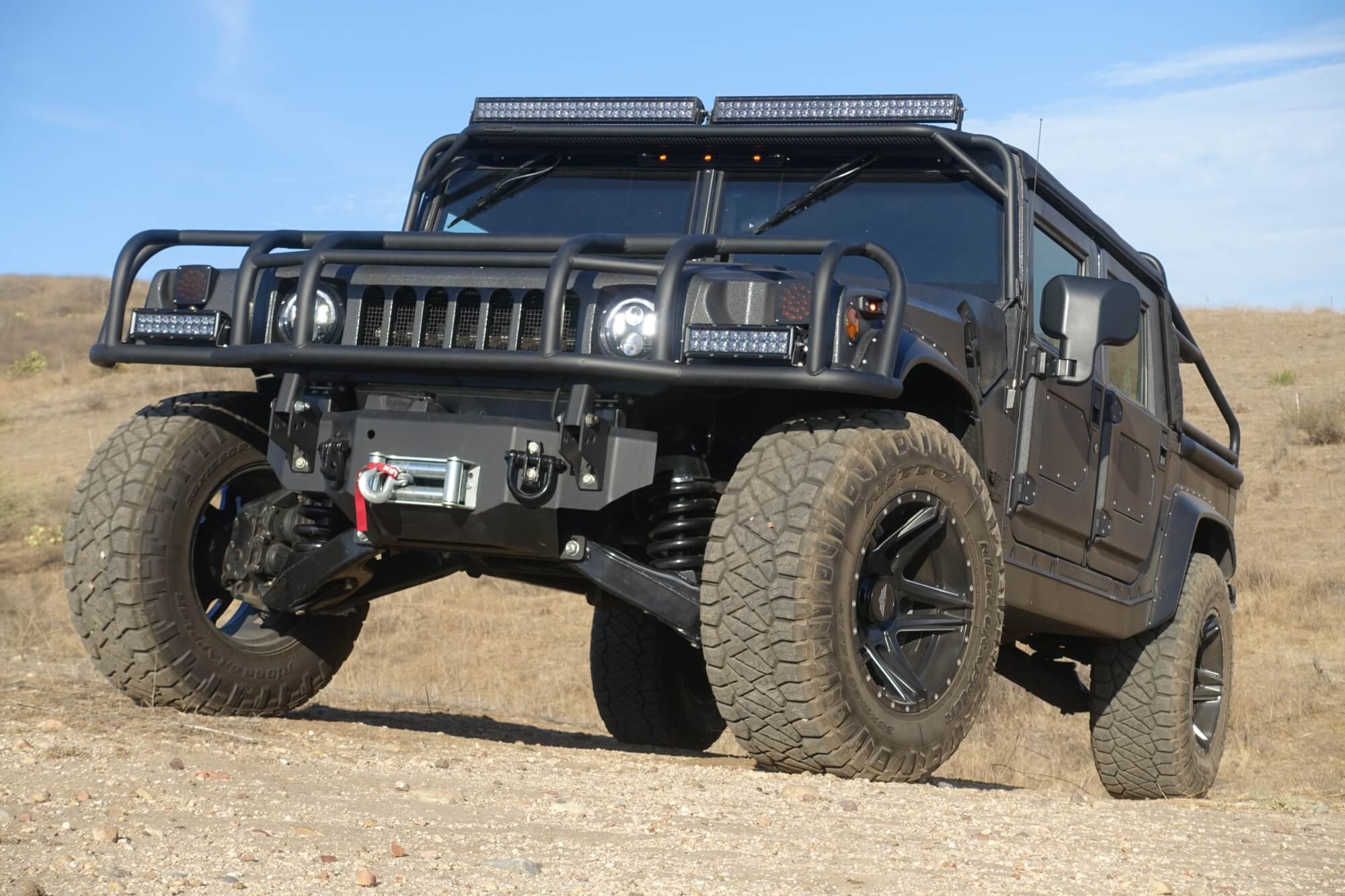
It might have the articulation of a sheet of plywood, giant dimensions, and the acceleration of a dump truck, but the Hummer H1 was strangely capable. Photo: Ben Stewart
1992-2006 Hummer H1
The original Hummer H1 is massive and massively capable. The key features of this wild military machine are all in the drivetrain. The four-speed automatic, NVG 242 transfer case and AMC Model 20 differentials (with Torsen limited-slips) are tucked up high, between the frame rails for excellent clearance. And that was accomplished thanks to the H1’s four-wheel independent suspension and planetary geared hubs with 1.92:1 reduction. So, when all that was combined with the huge 37-inch tires, it allowed the Hummer to have more than 16-inches of ground clearance—more than any other stock 4WD vehicle offered at the time. And those wheels and tires were fitted with a central tire inflation system that allowed owners to air down for the trail without ever leaving the driver’s seat, for maximum traction on any surface. So, in many cases, the impossibly wide, high-clearance Hummer could roll over obstacles that would hang up lesser 4X4s. If the Hummer lost traction, it’s brake-based traction control system would step in. Most civilian H1s came with a GM 6.5L turbo-diesel V8, but some used a gas 5.7L V8. In either case, the Hummer was super slow. Extra grunt came in the Alpha model from the last two years of the H1’s production. Alphas used a 300 horsepower 6.6L Duramax diesel. The Duramax’s 520 lb-ft of torque was backed by a strong five-speed Allison automatic. The H1 drove like the giant, heavy military beast it was. But its unique design allowed it to go places that would stop most other stock vehicles.

With its double digit horsepower and almost toy-like dimensions, some might laugh at the Samurai. However, it can get around obstacles and go places where other vehicles simply won’t fit. Photo: Wikimedia
1985-95 Suzuki Samurai
It seems appropriate to go from the largest vehicle on this list to the very smallest. The tiny Samurai rode on a short 80-inch wheelbase—four inches shorter than a CJ-5. The Samurai might be small, but it was one tough little 4X4. At each end was a robust solid axle suspended by leaf springs. These rigs are easy to modify and, because of their size, can steer around obstacles and slide into tight spots like no other 4X4. And because these no-frills 4X4s use manual controls for just about every function, there’s less to break on the trail. Some say the ones to look for are the 1991-up models because they came with fuel injection and more power (a whopping 66 horsepower). Samis are pokey, but they’re also feathery light at just over one ton. That means that with some slightly larger floatation tires a Sami is an excellent dune cruiser, despite its modest engine power. But the best part about a Samurai these days is that, for the most part, their prices haven’t been totally spiked by car collectors digging on vintage 4X4s. Downside? They feel a bit too small and slow on today’s freeways.
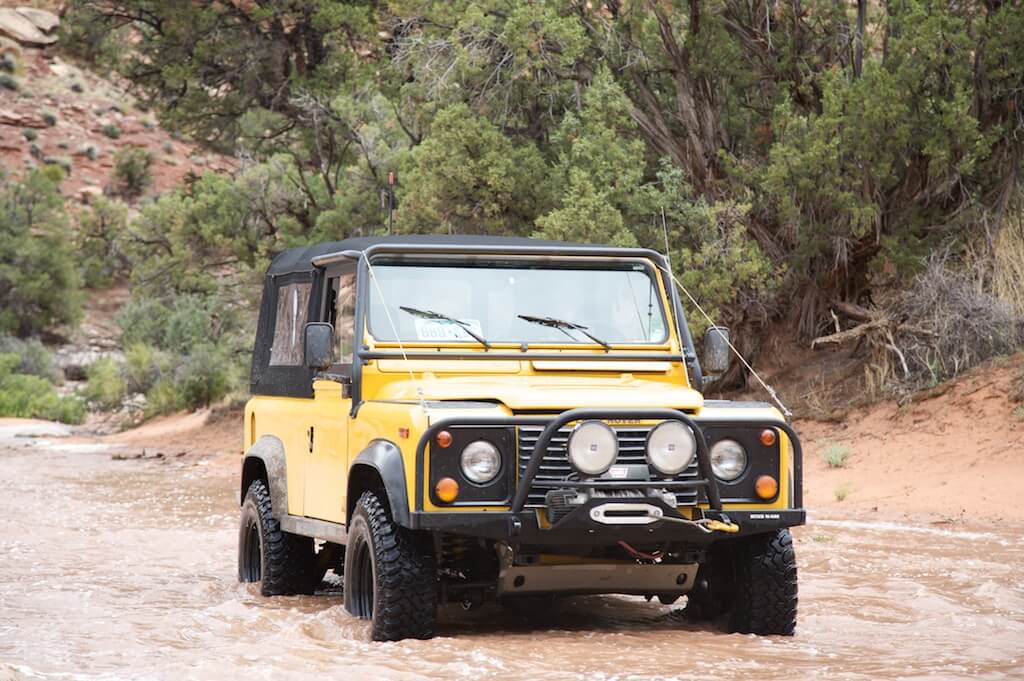
The Land Rover Defender is extremely capable straight from the factory. Only brought to the U.S. in very limited numbers, it has also become extremely expensive with its current price way beyond its original MSRP. Photo: Nick Taylor
1993-97 Land Rover Defender
When the North American Spec (NAS) Defenders finally came here in the early 1990s, fans of the Land Rover brand were thrilled. For the first time, we could experience the legendary, aluminum-bodied descendant of the original Series Land Rovers. The first 500 Defenders (110 model) arrived in 1993 as a single spec model—all of them were white four-door wagons with a 110-inch wheelbase powered by a 3.9L V8 backed by a five-speed manual. Solid axles and coil springs were at each end of the robust chassis and steel wheels capped each corner. As one might imagine, the Defender 110 is an incredibly strong machine. And what’s neat is that the ones that came here were fairly bare bones, making them at home on the trail. The 110 was only available for that one model year. But just 12 months later, the shorter wheelbase, two-door Defender 90 hit dealers and became the trail machine enthusiasts craved. The 90’s chief competitor was the Wrangler. And, at the time, when driven on a tough trail back to back, the 90 was just a little bit more capable than a non-Rubicon TJ thanks to its tall 265/75R16 BFG All-Terrain tires, excellent articulation and a taller overall stance for better trail clearance. Our favorite for ‘wheeling are the later automatic-equipped hardtop models. The only thing we’d add to one are some sort of locking diffs. But as good as the Defender is, it has one major flaw—a thirsty V8 fed by a small fuel tank. Despite this, several years ago, the collector car market decided Defenders were cool and devoured them. So, as great as Defenders are off-road, they can be hideously expensive these days.
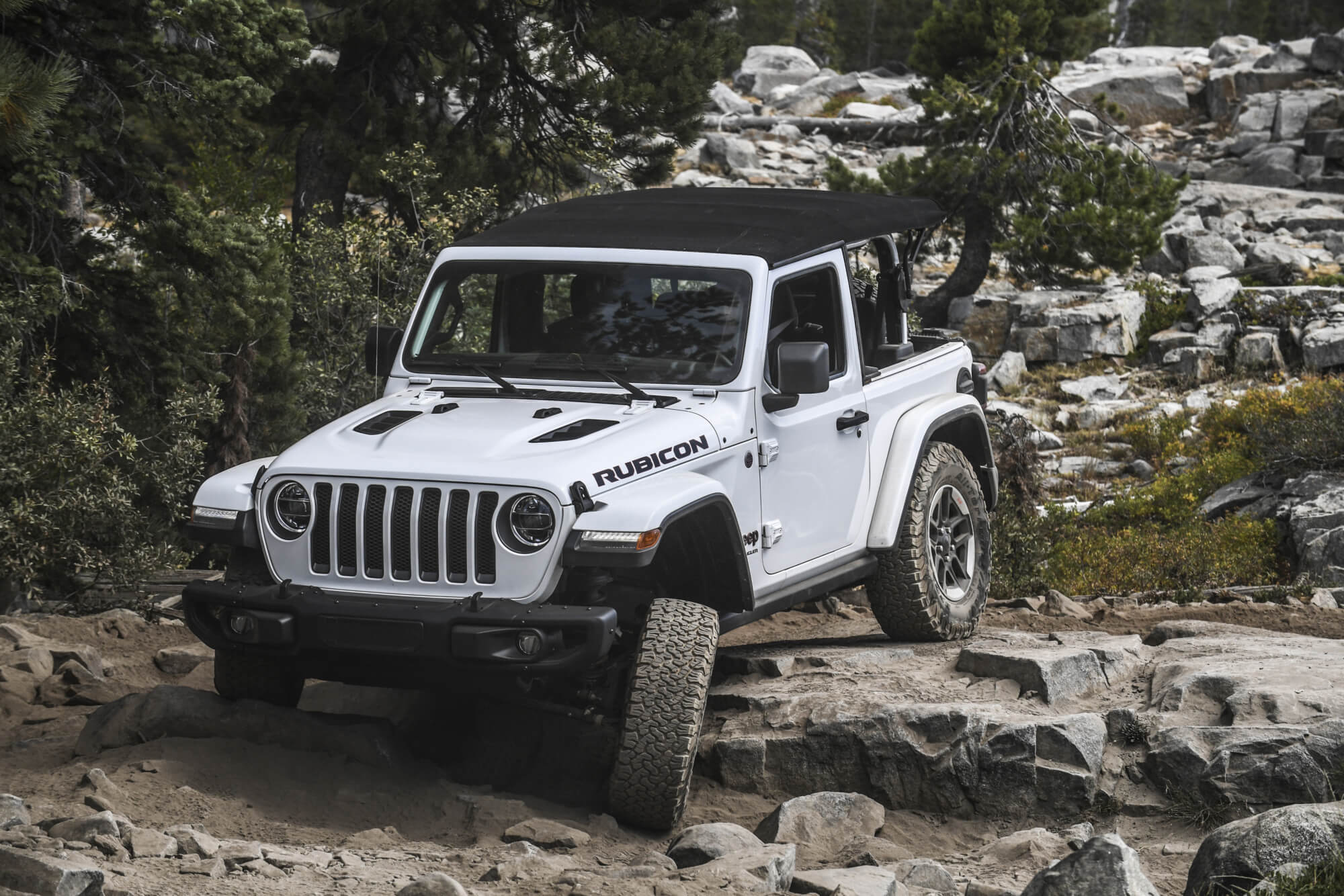
The Jeep Rubicon is at home on the trail (or any trail for that matter) that it is named after. It is a great choice for those that will actually use the full capability of their four-wheel drive. Photo: Jeep
2003-19 Jeep Wrangler Rubicon
Is there a vehicle that’s more popular on hardcore trails than the Jeep Rubicon? Nope. The Rubicon began as a skunkworks project in the late 1990s developed by Jeep engineers that were real four-wheelers. They started with a wish list of parts that Jeepers were looking for in a more hardcore Wrangler. That first TJ Rubicon featured some incredible gear for the time: Dana 44 axles loaded with selectable lockers, a 4.0:1-geared transfer case, aggressive mud tires and rocker panel protection. But when the next-JK generation arrived in 2007, Jeep added a crucial piece of equipment—the electronic disconnecting front swaybar. This increased articulation instantly from the comfort of the front seat and really helped boost the Rubicon’s popularity along with the availability of four doors. Thanks to the new swaybar, the JK Rubicon would keep its tires on the ground in places where the old TJ would sky a front wheel high into the air. Today’s JL Rubicon and Rubicon Unlimited carries forward the traditional Rubicon equipment, but mounts it all to a stiffer frame and uses stouter components. Plus, engineers were able to boost the crawling ability and carve out room in the fenders for big 33-inch stock tires (or 35-inchers with a mild lift). Lock both front and rear axles, disconnect that front swaybar and a Rubicon will climb over boulders better than any factory 4X4 today. No wonder so many people who actually go off-road park a Rubicon in their garage.
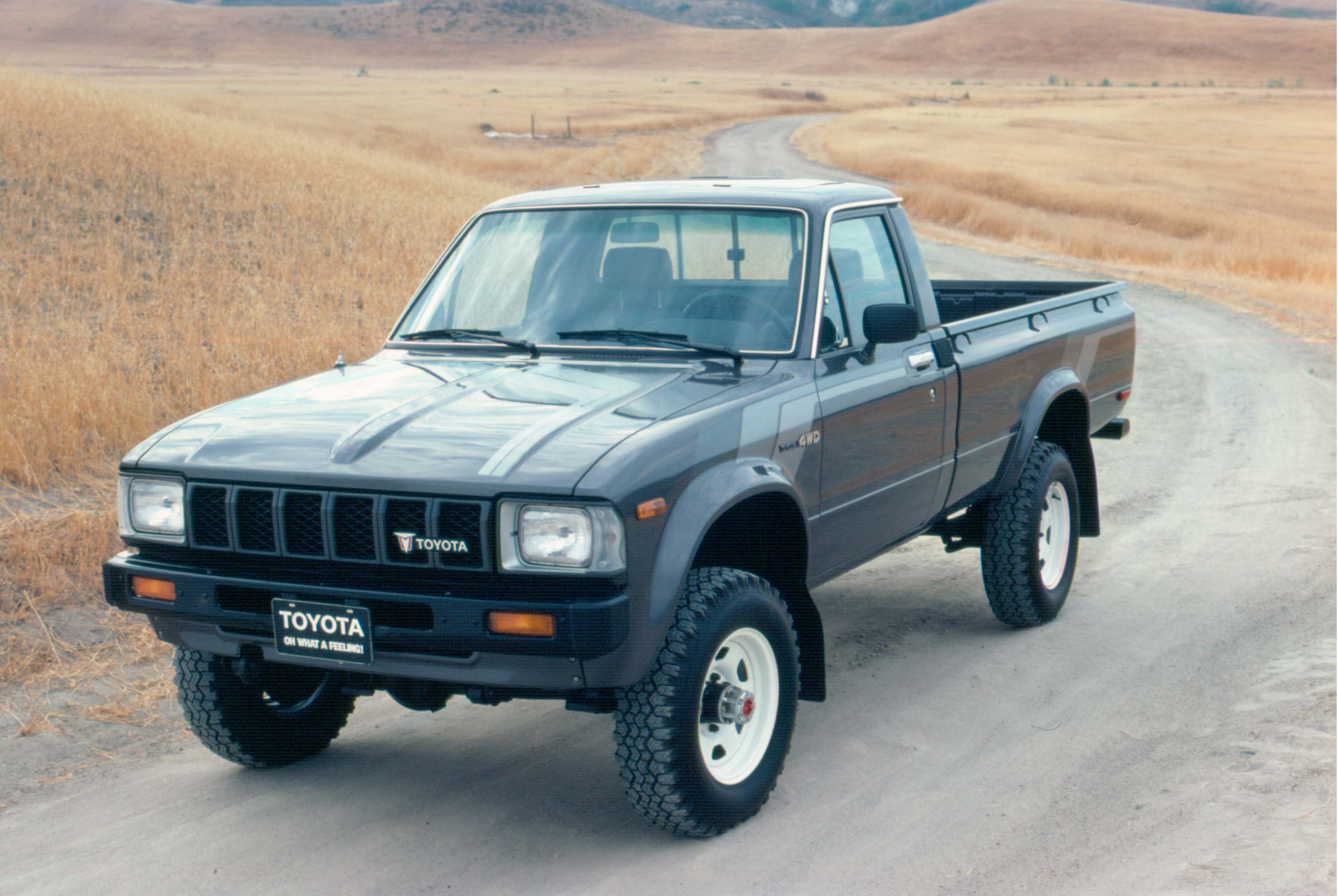
With their solid axle suspensions and mini-truck dimensions, the 1979-85 Toyota trucks are at home on the trail. They might not win any drag races, but they are extremely hard to kill, simple to work on, and still have a solid aftermarket following. Photo: Toyota
1979-85 Toyota Trucks
When it comes to durable 4X4s, the classic Toyota pickup from the late 1970s and early 1980s is at the top of everyone’s list. These trucks were overbuilt and when cared for (or even when they are neglected) they seem to run forever. At the heart of all this clockwork-like reliability was Toyota’s four-cylinder engine family. The 2.0L 20R, 2.4L 22R and later 22RE with fuel injection (with a whopping 105 horsepower) are all know to accrue deep six-figure mileage numbers without failure. The Toyota pickup was the first factory 4WD mini truck. Because the company had decades of experience building its legendary Land Cruiser models, that’s where some of this truck’s parts were sourced. At each end of the chassis is a Toyota 8-inch solid axle suspended by leaf packs—easy to lift and modify for trail use. But these trucks stood tall on their stock suspensions, which helped them provide outstanding trail capability out of the box. There’s still extensive aftermarket support for these trucks. Those 8-inch axles can be fitted with a variety of lockers and the transfer case can be loaded with lower gears for excellent crawl-ability. Some say the earlier, rounded fender models from 1979-83 can fit larger tires than the more modern and angular 1984-85 models. But only the later ones could be had with the Xtracab option with a half-foot more room behind the front seats. And the 1984-85 first-generation 4Runners share all the same parts and are equally great four-wheelers. But beware, car collectors now have a taste for old trucks and all these old 4WD Toyotas have been creeping up in value.
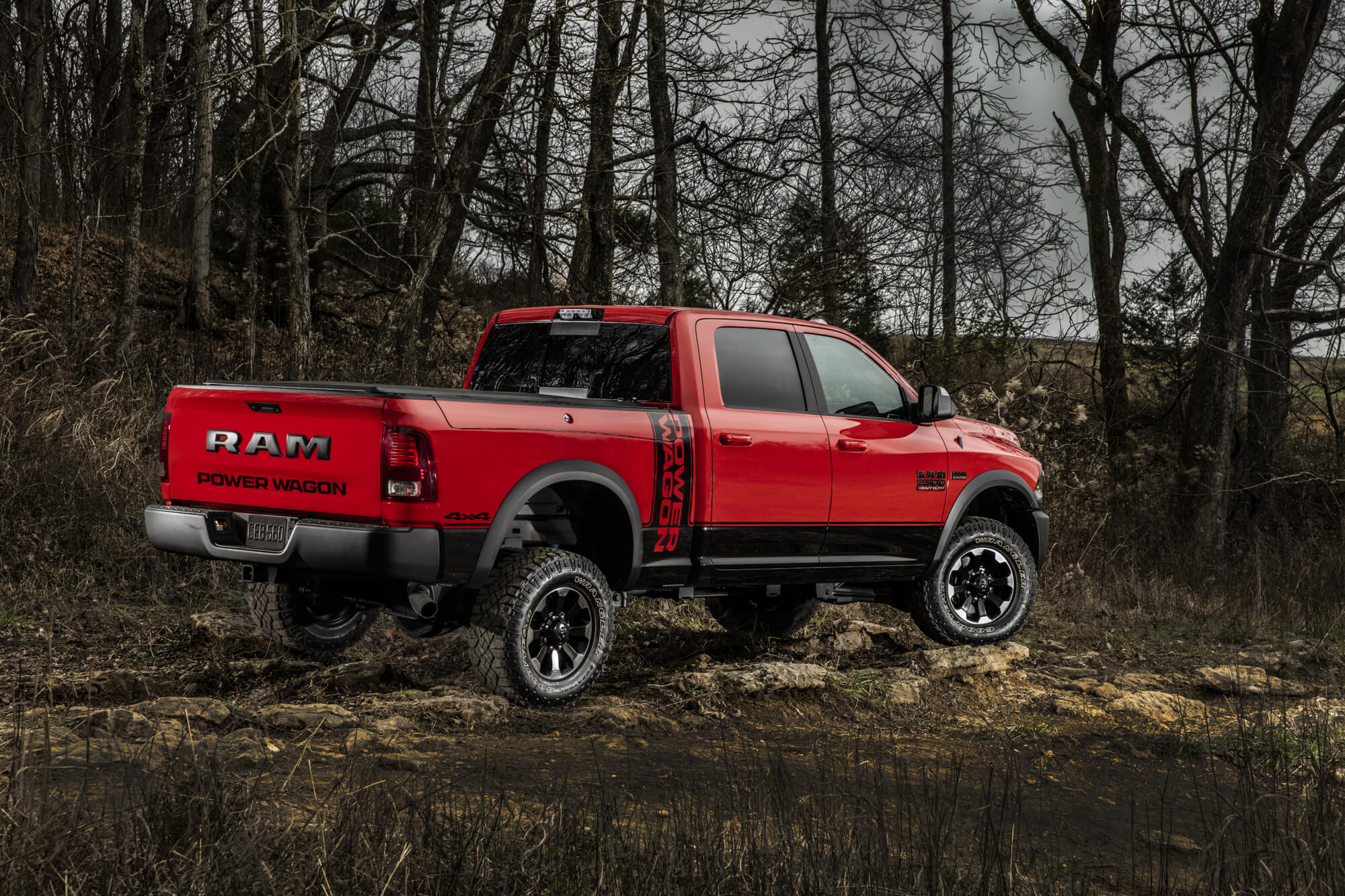
When it comes to full-size trucks, many only think of the Raptor when it comes to off-road prowess. However, the Power Wagon is very adept at slower speed work and can still be used as a truck. Photo: Ram
2005-19 Dodge/Ram Power Wagon
The Dodge Power Wagon’s spec sheet reads like a four-wheelers dream. Back in 2005, Dodge decided to produce a truck that could dominate all others when the road turned rough and they succeeded. The re-born Power Wagon was developed with hardware not found on any other pickup at the time. The first models, like the Power Wagons today, are based on 2500-series Dodge/Ram pickups. The hefty chassis was paired to heavy-duty solid axles at each end with 4.56:1 gears. And, the big Hemi V8 (5.7L at first and now up to 6.4L) had a choice of automatic or manual transmissions, although that manual option was dropped after the first generation. Later Power Wagons received more freeway friendly 4.10:1 gears and more gears in the transmission, now up to 8-speeds for improved fuel economy and crawling ability. Unlike any other full-size truck, for true four-wheel drive each diff was fitted with an electronically-locking differential. To further enhance trail performance, the suspension was raised two inches and the front axle was equipped with an electronic disconnecting front swaybar to unlock significant amounts of articulation. The 33-inch tires are retained in every generation of Power Wagon. And while that’s modest rubber for a truck like this, rest assured the Power Wagon is the only factory 4X4 in the US that comes armed with a 12,000-lb. Warn winch up front. Our pick? The new 2019 model with the 8-speed transmission. Oh, and ours would undoubtedly have to wear the retro 1970s “macho” decals too.
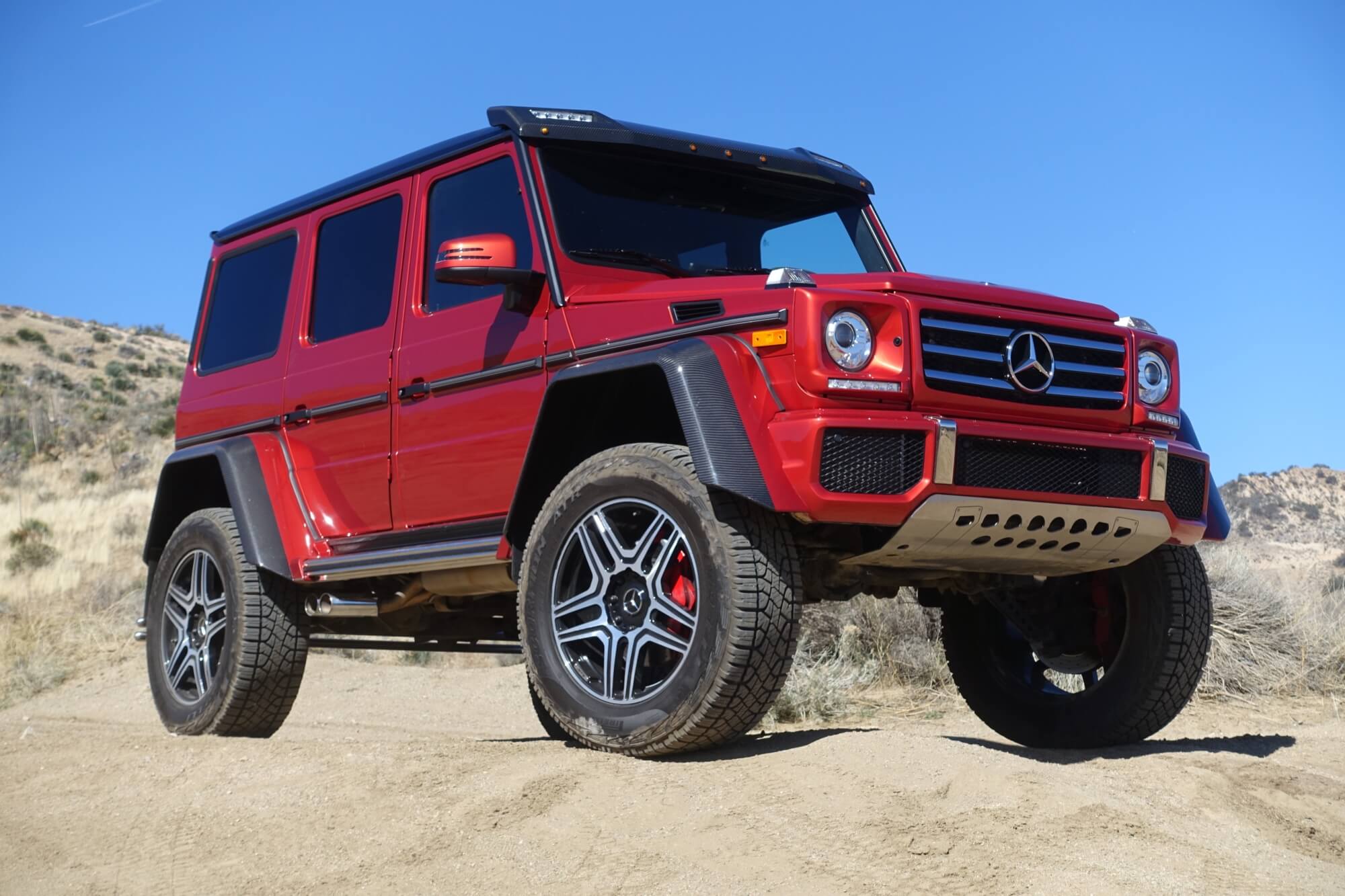
We can count the times we have seen a G-Wagen off-road on one finger. That is probably due to them being the price of a house, but they are just as home in the dirt as at the mall. Photo: Ben Stewart
1979-2018 Mercedes-Benz G-Wagen
The G-Wagen was developed for military use back in the late 1970s, so it’s boxy design and rugged solid axle suspension were proven for severe-duty conditions. Mercedes-Benz officially brought the G here in the early 2000s. Most are powered by V8s (G500/G550), but some have ridiculously potent engines under that slab-sided hood, like the V8 AMG G63 and the G65 which uses a ludicrous 621 horsepower V12. Most G-Wagens on the road are newer ones usually driven by fancy people in fancy parts of town. But here’s the thing, every one of these trucks came with an electronic locking differential in both solid axles. So, with perhaps a tire switch, lift, and some rock sliders a G-Wagen with a past life crawling mall parking lots can take on some fairly gnarly trails. And even in stock form, Mercedes says they will ascend or descend slopes of 45 degrees. The pinnacle of G-Wagen insanity came in the way of the G550 4X4 Squared—a beast that rode on 37-inch tires and could clear 18-inch obstacles under the diffs thanks to factory portal hub axles. At over $200,000 each, these high-riding limited-edition monsters with a 51.6-degree approach angle and a 43.8-degree departure angle were some of the most radical factory 4X4s of all time. And they are indeed fun machines to ‘wheel. The latest 2019 G-Wagen models have been completely redesigned but have unfortunately lost their solid front axle. The good news is that some of the earlier and less expensive ones from the ‘80s and ‘90s are starting to come to the states. So, with some digging, you can find relatively bare-bones G-Wagen for a fraction of the price of the newer ones.
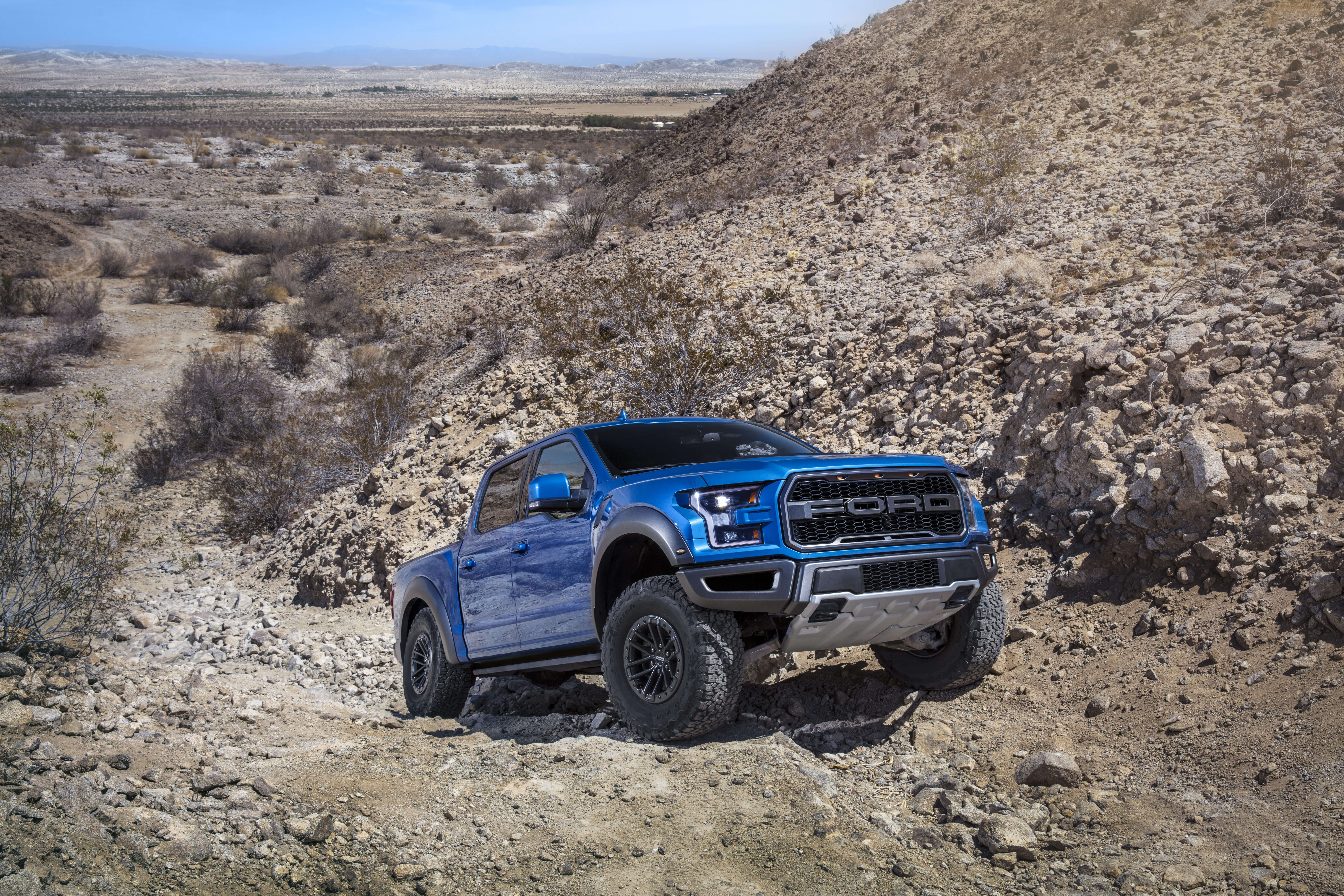
If you are like Ricky Bobby and want to go fast in the dirt, then get a Ford Raptor. There really is no substitute. Photo: Ford
2010-19 Ford F-150 SVT Raptor
The Ford Raptor is the truck of choice for anyone that yearns to hit high-speed desert whoops like a pre-runner in a factory fresh 4X4. Ford’s Special Vehicle Team, a group that normally focuses on speedy pavement machines, aimed their talents at Ford’s F-150 4X4. Both the first and second generation Raptor (which arrived in 2017) are powerhouse trail machines. A wider track width allows today’s Raptor to have more than a foot of wheel travel up front and almost 14 inches in the rear. And it’s all damped by Fox shocks and covered by wide, blistered fenders. That’s a straight-up astounding suspension for a production 4X4. And when combined with the brawny 6.2L V8 of the original (very early ones had a 5.4L V8) or the potent 450 horsepower 3.5L twin-turbo V6 of today’s truck—the Raptor can soar across a two-track loaded with big bumps. But what’s cool about the Raptor is that it’s a talented performer when locked in low range as well. Thanks to an amazing terrain management system on the second-generation model, a rear electronic locking diff and a Torsen in the front axle as well as the tall 315/70R17 tires, Raptors can dispatch tough slow-speed trail sections. Simply put, no other factory 4X4 can hang with the Raptor for high and low speed four wheeling as long as it will fit where it is going.
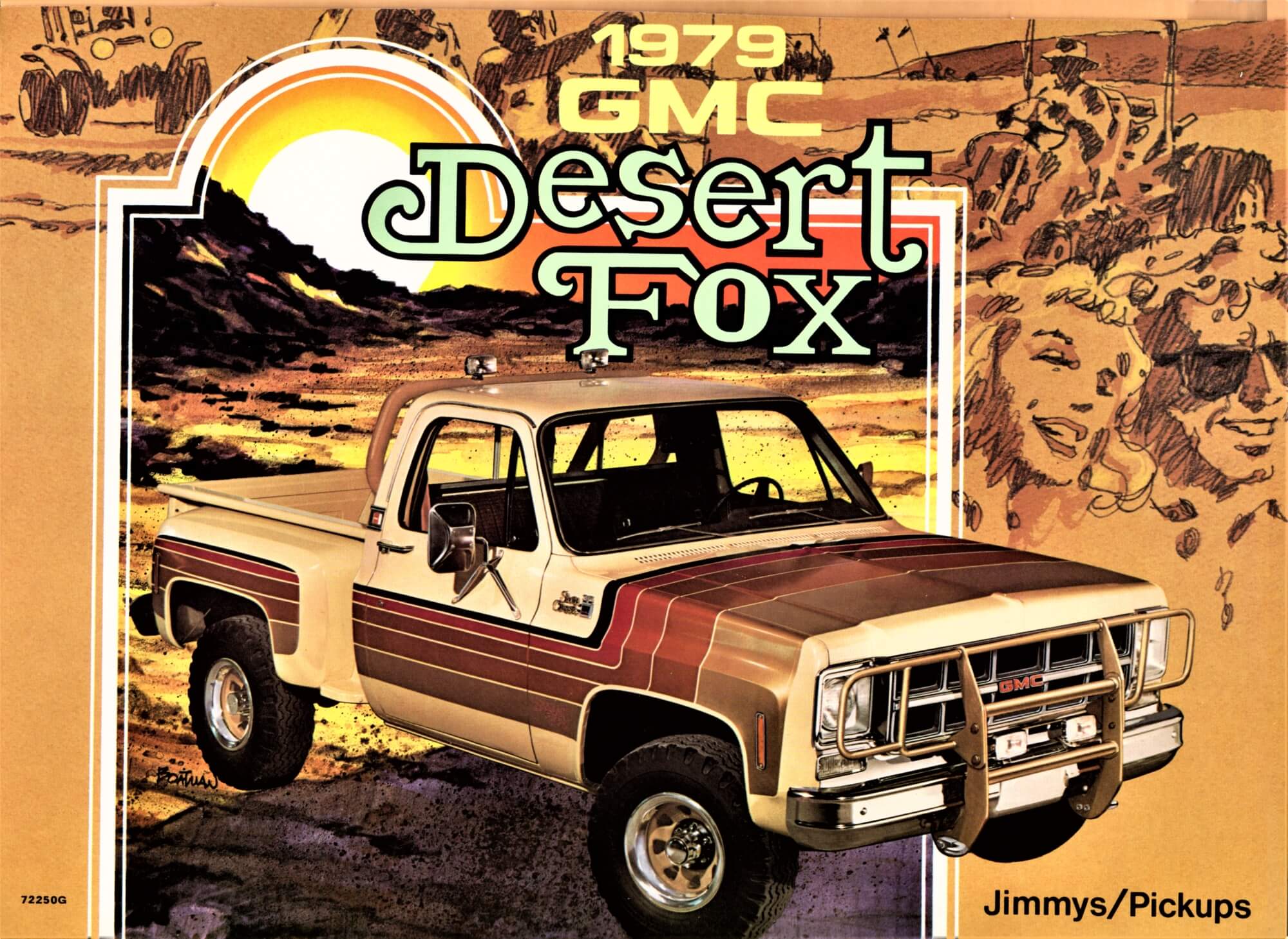
The square-bodied Chevy pickups never had an official off-road package. Only the extremely rare Desert Fox trucks came close, but they really didn’t need one. Simple to work on, extremely rugged, and with solid axles front and rear they could handle any task. Photo: Wikimedia
1973-91 Chevy/GMC K-Series
The square-bodied Chevy and GMC trucks never really had a real factory off-road package. The closest it came to such a thing is ridiculously rare Hickey-developed Desert Fox trucks that could be purchased through GMC dealers. But what the factory square bodies did have was an excellent combination of proven parts that could be trusted on the road or trail. Most of these machines have a simple and reliable combination of a 350 V8 and Turbo 350 transmission. In terms of drivetrain gold, the high point for half-tons has to be the late 1970s when the bomb-proof granny-low SM465 four-speed manual was available and partnered to the NP 205 transfer case for splitting the power. These trucks also benefitted from the stronger 12-bolt rear axle too. No matter the gearbox fitted, the square-bodied GM trucks are very receptive to suspension modifications. Done right a simple 2-inch lift can unlock loads of wheel travel and articulation. And thanks to big wheel wells, 35-inch tires can fit without much trimming. The last heavy-duty K30 models used a 454 V8 with EFI under the hood. Because these trucks had a beefy Dana 60 front axle and Dana 70 in the rear, they could handle huge tires and locking differentials without failure. The square body trucks continued until 1991 but only as a short-wheelbase Blazer/Jimmy or as long-wheelbase crew cab K30. Our favorite square-body GM trucks are the oddball Blazer Chalet and GMC Casa Grande mini motorhomes. These rigs offered serious overland four-wheeling ability back when we all just called it camping.



2